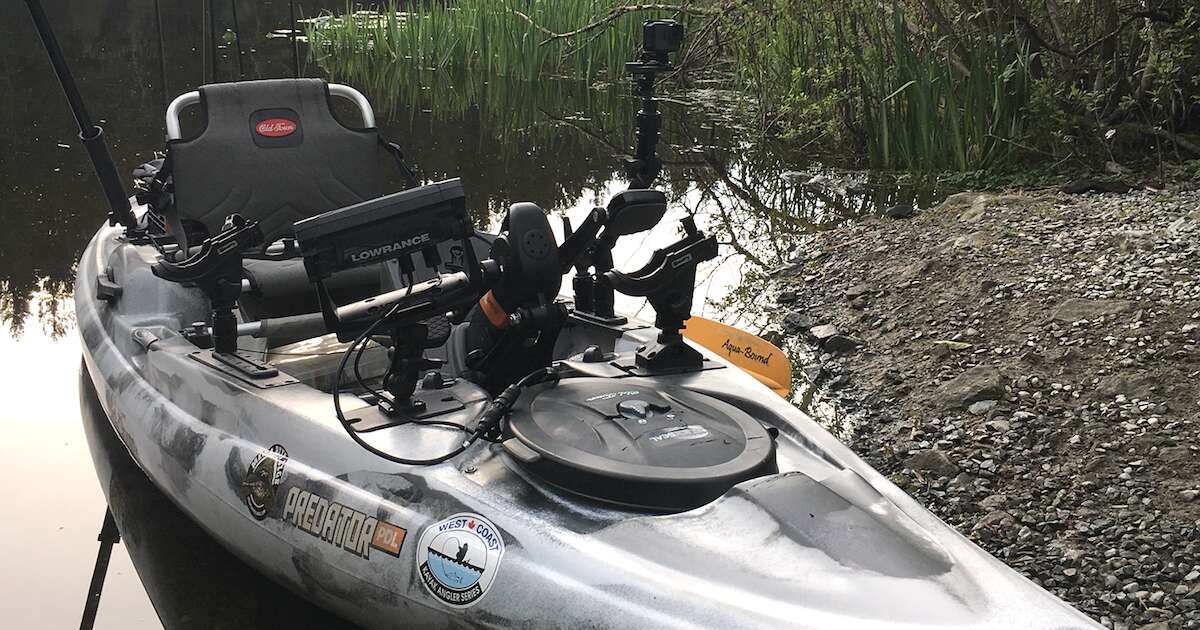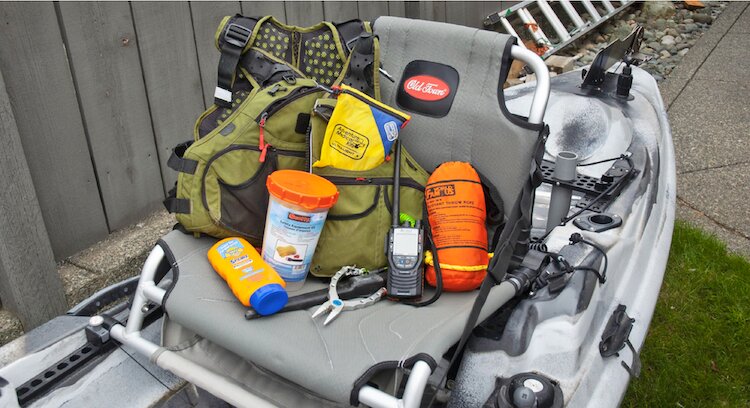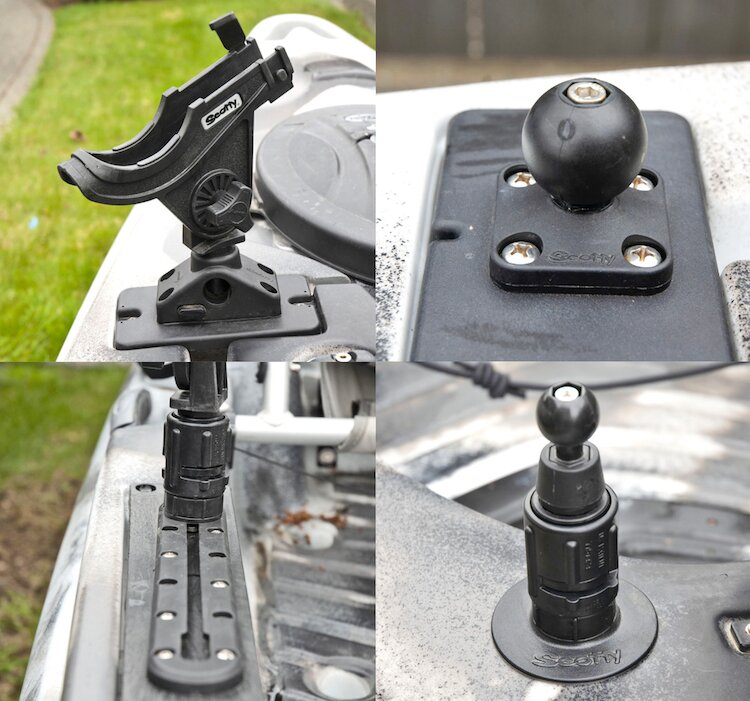
In the first two installments of this series, we’ve helped you buy your first fishing kayak. Now you want to rig it up. You look at the wall of adapters and attachments, and your head starts to spin. Where do you start? Let’s break it down to three things: safety, functionality, and fun. The best feedback for people starting out in the sport is “keep it simple.” It’s easy to see some of us regulars on the water with all the bells and whistles and say, “I’ve got to have that.” But you should start by evaluating your intended uses and work from there.
Kayak Safety Gear
Getting home safely is our number one priority, and it begins with a Canadian Coast Guard-approved PFD (personal flotation device/life jacket). If you don’t have one, don’t leave the store without this purchase—your kayak is useless without it. Next, although not required (unless you add an electric motor), is the Pleasure Craft Operator Card (PCOC).
Next comes the safety equipment. Transport Canada regulates kayakers, and we must have a PFD, a signaling device (whistle), and a floating throw line (15 m). If we plan to be on the water before sunrise or after sunset, we must have a waterproof flashlight (signaling device) as well.

Kayak Gear Selection: endless options of styles and performance. Determine your planned use before buying.
Outside of these minimum requirements, there are other items like hand bilges, bailer, compass, radar reflectors, navigation lights, etc. that Transport Canada lists as additional items subject to your kayak type and planned uses (generally, how far offshore you may go). All this information is nicely packaged in the iBoat app, which also has some useful checklists.
Okay, so that’s it, right? Nope. There are a couple of other items not listed by Transport Canada that I believe are must-haves, especially for those going offshore.
Kayak Safety Gear Checklist
- Flagpole with flag and light. We are hard to see on the water, especially if there is any swell. We need to ensure we are seen, so don’t leave home without it.
- Floating VHF Radio (Saltwater). No, this is not for ordering pizza (although you can). It provides immediate access (CH16) in emergency situations. Reminder,
if you own a VHF, you need to have your Restricted Operators Certificate – Maritime to use it. If you’re simply fishing the local lake, consider having an FRS two-way radio. You can use this to communicate with other ’yak fishers or, if fishing solo, leave with someone onshore for safety. - First aid kit. As fishermen, we always have hooks and knives on board and it’s better to be prepared.
- Eyewear. We need our eyes for tying hooks, landing fish, sighting fish, etc. Always wear some form of eye protection.
- Toilet Paper. Yes, I know it’s in high demand these days. You don’t need a full roll, just emergency supply (and in a sealed plastic bag).
I know that was tedious, but the bottom line is that we want to get you on and off the water safely.
Kayak Gear and Tackle Management
Most of today’s fishing kayaks come with a couple of “flush mount” rod holders and preinstalled track or places to install aftermarket track. You can check out all the options available from manufacturers like Scotty, Yak Gear, and Yak Attack (I encourage you to shop local).

Four mount-type formats: block (top left), track (bottom left), ball (top right) and glue on (bottom right).
It takes a while to figure out where we like to position things on our kayaks, and this differs between pedal drives and paddlers, as things interfere differently depending on propulsion. My basic list is rod holder, tackle tray, paddle clip and leash, waterproof phone case, pliers, and a knife. For additional storage, adding a crate and dry bag is practical for safety gear, snacks, and spares. Starting with the basics allows you to see what you like, where you like it, and how to manage the gear on board.
After a few times out, you will start to determine your preferences and may want to add things such as fish finders, additional rod holders, anchor trolley, cup holder, camera mounts—really, there is no limit. A word of caution, though: The more you add, the more there is to get tangled or for your trophy fish to wrap itself in. Gear and tackle management on deck is an important skill to learn, and one I am continuing to figure out.
Many people ask me about “leashing” and securing rods and gear to your kayak. I certainly think paddle leashes are a good idea, but beyond this I would look to other options like pool noodles and zap straps. If you ever flip, a web of leashes in the water secured to the deck is a spider web, and can entangle the best of kayakers.
Kayak Rigging for Maximum Fun
And now on to the most important item—ensuring you have fun on the water. How does this relate to “rigging up” you ask? The first two items are rigging up the ’yak, but now we have to rig you up for success.
First of all, dress for success. Believe it or not, kayak fishing on the west coast is a 12-month sport as long as you are equipped for it.
Remember the general 120° F rule: If the air temperature and water temperature don’t add up to 120° F, there is a high risk of hypothermia.
Dressing accordingly is critical. Most important are good footwear, layering, and preferably lightweight (non-water absorbing) SPF materials. Additionally, good moisture-wicking materials are a benefit—whether you are pedaling or paddling, you can work up quite a sweat. Finally, have a variety of clothing for precipitation, dry weather, excess heat, etc.

Dress for Success
Please don’t wear waders on your kayak. I see lots of videos on YouTube where the fishermen are wearing waders. If you capsize, these are going to fill up and behave like a huge anchor, unless you are fishing in less than 3′ to 4′ of water. There are many great options for keeping your legs dry available from kayak retailers.
The last item under “Dress for Success” is a change of clothes. In the event you do flip, or the weather is wet, changing into dry clothes when returning to shore makes for a great end to the day and can help prevent unknowns like hypothermia.
You’ll also want to be sure to have plenty of water and snacks. Staying hydrated on the water is key to a successful day and an important part of your rigging. Having fluids and snacks packed and on board at all times is a prudent measure. I generally keep a small dry bag in my crate or hatch at all times.
Kayak, tackle, rod holders, safety gear, appropriate clothing, food, and water. Check. You’ve got almost everything you need—don’t forget the license! Be safe, and take a family member fishing with you.
This article appeared in Island Fisherman Magazine. Never miss an issue, subscribe today!
Visit the Store
$34.99
$34.99
Featured Catch

Joel Unickow halibut (Photo: Rob Frawley Lucky Strike Sportfishing Tofino)







